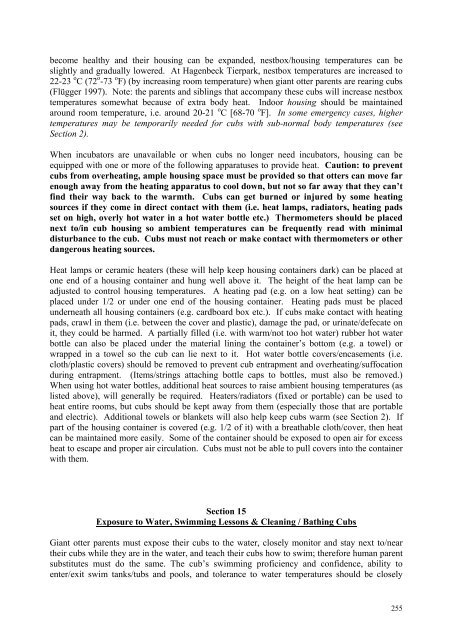International Giant Otter Studbook Husbandry and Management
International Giant Otter Studbook Husbandry and Management
International Giant Otter Studbook Husbandry and Management
You also want an ePaper? Increase the reach of your titles
YUMPU automatically turns print PDFs into web optimized ePapers that Google loves.
ecome healthy <strong>and</strong> their housing can be exp<strong>and</strong>ed, nestbox/housing temperatures can be<br />
slightly <strong>and</strong> gradually lowered. At Hagenbeck Tierpark, nestbox temperatures are increased to<br />
22-23 o C (72 o -73 o F) (by increasing room temperature) when giant otter parents are rearing cubs<br />
(Flügger 1997). Note: the parents <strong>and</strong> siblings that accompany these cubs will increase nestbox<br />
temperatures somewhat because of extra body heat. Indoor housing should be maintained<br />
around room temperature, i.e. around 20-21 o C [68-70 o F]. In some emergency cases, higher<br />
temperatures may be temporarily needed for cubs with sub-normal body temperatures (see<br />
Section 2).<br />
When incubators are unavailable or when cubs no longer need incubators, housing can be<br />
equipped with one or more of the following apparatuses to provide heat. Caution: to prevent<br />
cubs from overheating, ample housing space must be provided so that otters can move far<br />
enough away from the heating apparatus to cool down, but not so far away that they can’t<br />
find their way back to the warmth. Cubs can get burned or injured by some heating<br />
sources if they come in direct contact with them (i.e. heat lamps, radiators, heating pads<br />
set on high, overly hot water in a hot water bottle etc.) Thermometers should be placed<br />
next to/in cub housing so ambient temperatures can be frequently read with minimal<br />
disturbance to the cub. Cubs must not reach or make contact with thermometers or other<br />
dangerous heating sources.<br />
Heat lamps or ceramic heaters (these will help keep housing containers dark) can be placed at<br />
one end of a housing container <strong>and</strong> hung well above it. The height of the heat lamp can be<br />
adjusted to control housing temperatures. A heating pad (e.g. on a low heat setting) can be<br />
placed under 1/2 or under one end of the housing container. Heating pads must be placed<br />
underneath all housing containers (e.g. cardboard box etc.). If cubs make contact with heating<br />
pads, crawl in them (i.e. between the cover <strong>and</strong> plastic), damage the pad, or urinate/defecate on<br />
it, they could be harmed. A partially filled (i.e. with warm/not too hot water) rubber hot water<br />
bottle can also be placed under the material lining the container’s bottom (e.g. a towel) or<br />
wrapped in a towel so the cub can lie next to it. Hot water bottle covers/encasements (i.e.<br />
cloth/plastic covers) should be removed to prevent cub entrapment <strong>and</strong> overheating/suffocation<br />
during entrapment. (Items/strings attaching bottle caps to bottles, must also be removed.)<br />
When using hot water bottles, additional heat sources to raise ambient housing temperatures (as<br />
listed above), will generally be required. Heaters/radiators (fixed or portable) can be used to<br />
heat entire rooms, but cubs should be kept away from them (especially those that are portable<br />
<strong>and</strong> electric). Additional towels or blankets will also help keep cubs warm (see Section 2). If<br />
part of the housing container is covered (e.g. 1/2 of it) with a breathable cloth/cover, then heat<br />
can be maintained more easily. Some of the container should be exposed to open air for excess<br />
heat to escape <strong>and</strong> proper air circulation. Cubs must not be able to pull covers into the container<br />
with them.<br />
Section 15<br />
Exposure to Water, Swimming Lessons & Cleaning / Bathing Cubs<br />
<strong>Giant</strong> otter parents must expose their cubs to the water, closely monitor <strong>and</strong> stay next to/near<br />
their cubs while they are in the water, <strong>and</strong> teach their cubs how to swim; therefore human parent<br />
substitutes must do the same. The cub’s swimming proficiency <strong>and</strong> confidence, ability to<br />
enter/exit swim tanks/tubs <strong>and</strong> pools, <strong>and</strong> tolerance to water temperatures should be closely<br />
255

















